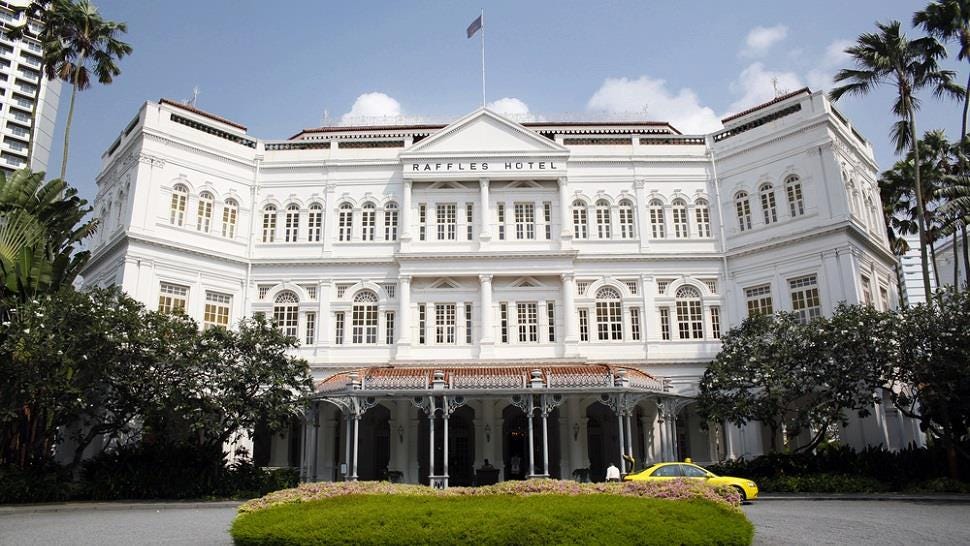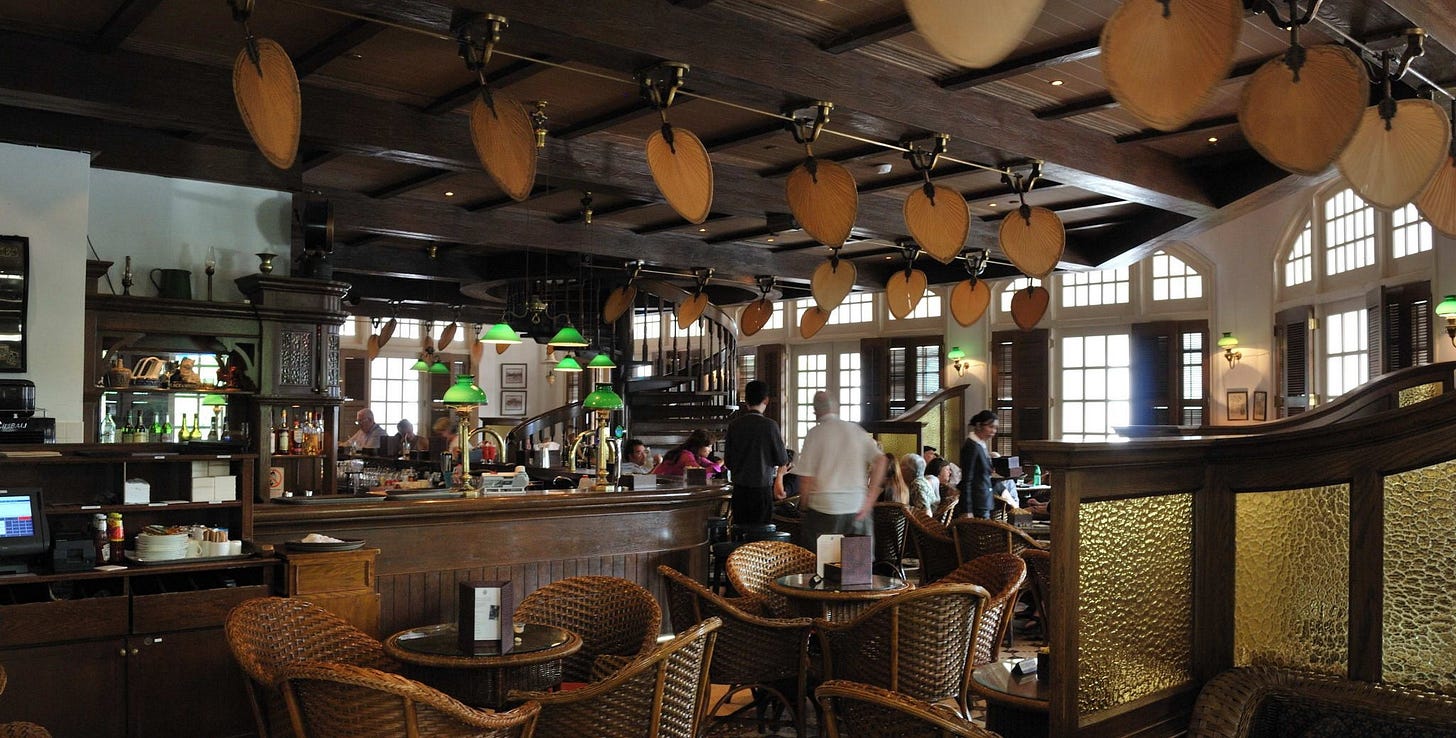The Singapore Sling - A moment in time
The subtle rebellion of the Singapore Sling
The Japanese naval officer at the bar, resplendent in his crisp uniform, pauses mid-sentence, his conversation momentarily forgotten. The tactical discussions with his British counterpart give way to a tactical assessment of a different kind.
Overhead, paddle fans stirred languidly, their revolutions struggling to cut through the sultry Singapore heat and the haze of cigar smoke.
A figure emerges through the haze and the low murmur of conversation. She glides through the room, her posture straight as a column, yet there's a fluidity to her movement that speaks of the dance floors where she earns her living.
She wears a figure-hugging traditional dress with a high mandarin collar, made of blue silk that shimmered in the dim light. Her hair is pinned up in an elegant bun with an ornate hairclip, a few deliberate strands artfully framing her face, and her eyes, dark and deep, scan the room with an air of confident appraisal. She approaches the bar, the subtle scent of jasmine trailing in her wake.
A group of Malay and Chinese businessmen, deep in animated discussion, glance her way, one raising his glass in a silent salute before they resume, voices lowered, with occasional looks towards the bar.
Seated in clusters, colonial officials, some with their wives, observed with a measured interest. The wives, adorned in dresses that speak of home counties and garden parties, fan themselves slowly, their eyes following the dancer with a more calculated look, one that balances admiration with a hint of caution, as if her independence and her beauty are a challenge to their world order.
As she approaches the bar, Ngiam Tong Boon looks up from his meticulous arrangement of bottles and glassware. With one slightly raised eyebrow, he takes in the uncommon sight of a lone woman at his bar. There's a spark of recognition in his eyes, — She's a taxi dancer, a lady whose grace on the dance floor is a commodity for her gentlemen patrons.
He greets her with a nod that is both welcoming and discrete, he inquires, "What may I have the pleasure of serving you tonight?"
She replied with a hint of a smile playing on her lips, 'A gin sling, please.'
As he prepares her drink with practiced hands, the ice clinks like a toast to her presence.
"Will it be on your account, miss?" he asks, with a questioning eyebrow.
"On the gentleman's at the corner table," she replies, with a small, knowing smile, indicating a suit-clad man whose attention is clearly fixed on her.
As she headed to the corner she thought how a little sweet, a little tart, and some gin make the uncertain world just a little more bearable.
In the Singapore of 1915, British officials lived in a bubble, German-occupied portions of China had been invaded by British ally Japan. Japan was expanding aggressively and causing issues for British diplomats due to their harsh treatment of China.
The British Empire had mobilized almost 1.5 million Indian troops. On the Western Front World War 1 was in a protracted stalemate of trench warfare. The warring powers were bringing new horrors to the battlefield, the second battle of Ypres saw the first use of poison gas. Muslim Indian troops had mutinied in Singapore at the start of the year, only put down when the British governor called on Russian and Japanese allies to help restore order.
Attitudes toward alcohol like many things in colonial life were dictated by the norms of London. And at this time it was frowned upon for women to be seen drinking in public. Typically women would order tea or fruit juice if they were out someplace like the Long Bar with their husbands.
As a sop to societal norms, Boon's creation, soon to be known as the Singapore Sling, was ingenious in its subtlety, masquerading the kick of alcohol behind the veil of innocent fruit juice. The Singapore Sling was born.
The Singapore sling was invented at the Long Bar in the Raffles Hotel in Singapore by Ngiam Tong Boon. The Raffles Hotel, frozen in time since 1915 and with all its colonial charm, stands today as a living museum of Singapore's imperial history. The hotel takes its name from Sir Stamford Raffles, the Englishman credited with the founding of Singapore and the expansion of the British Empire in the Far East.
The cocktail became an instant sensation, encapsulating the very essence of the tropics within a single glass. It is the national drink of Singapore.
Writers like Joseph Conrad and William Somerset Maugham, as well as actor Douglas Fairbanks, were among the many who favored this delightful concoction. Garnished with a slice of pineapple and a cherry, the Singapore Sling can transport you to another place.
The original recipe of the Singapore Sling remains a subject of much debate among cocktail historians, as Ngiam reportedly never documented it, and its ingredients and preparation were passed down through oral tradition.
However, it is commonly agreed that the key ingredients comprise gin, Cherry Heering liqueur, Bénédictine liqueur, and fresh pineapple juice, creating a perfect harmony of sweet, tart, and strong flavors.
Today, the Singapore Sling still evolves, as bartenders around the world infuse their creativity into this timeless classic. Variations abound, including an explosion of gin varieties, and the incorporation of local ingredients to impart a twist.
Raffles uses metric for its recipe :
Serve in a sling glass.
30 ml Gin (approximately 1 oz)
15 ml Cherry Heering liqueur (approximately 0.5 oz)
120 ml Pineapple Juice (approximately 4 oz)
15 ml Lime Juice (approximately 0.5 oz)
7.5 ml Cointreau (approximately 0.25 oz)
7.5 ml Dom Bénédictine (approximately 0.25 oz)
10 ml Grenadine (approximately 2 tsp)
A Dash of Angostura Bitters
Garnish with a slice of Pineapple and a Cherry
Subscribe to get updates as they are published.
Every few weeks I will publish a story starting with the story of some famous cocktails.




Michael, your writing is so descriptive. It's like watching a movie. We thoroughly enjoyed this. Jack and Genie